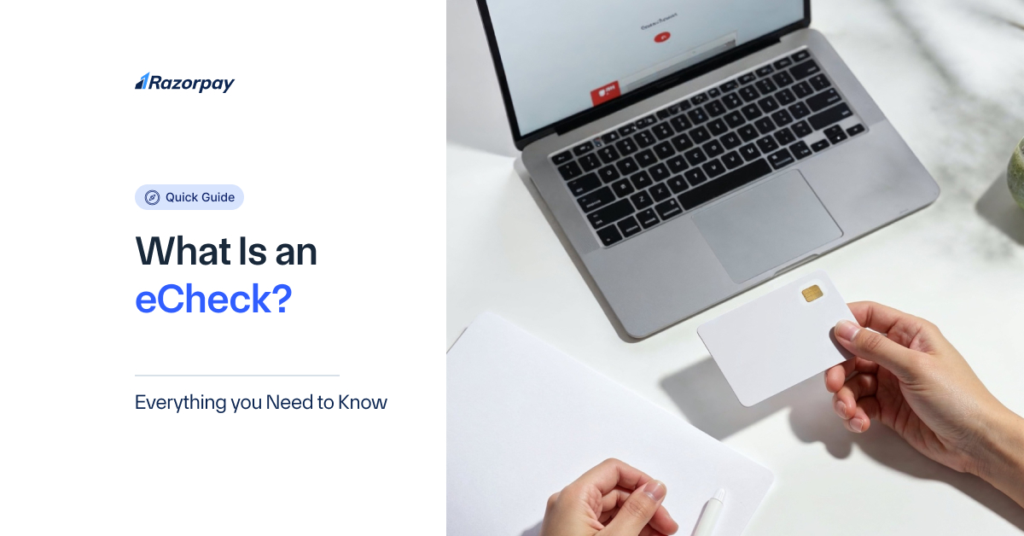In today’s fast-paced digital world, businesses are constantly seeking efficient and secure payment methods to streamline their financial transactions. One such solution that has gained significant traction is the electronic cheque, also known as an e-cheque or eCheck. This innovative digital payment method offers a convenient alternative to traditional paper checks, enabling faster processing times and enhanced security features. In this article, we will delve into the intricacies of electronic checks, exploring their functionality, benefits, and how they are revolutionising the landscape of payment processing.
Table of Contents
What Is an eCheck (Electronic Check)?
An eCheck functions as a secure and digital payment method that relies on the ACH network to facilitate transactions. When you initiate an eCheck payment, the funds are electronically withdrawn from your checking account, transmitted through the ACH network, and deposited into the payee’s account.
The process is straightforward and user-friendly, even for those who may not be tech-savvy:
- You provide authorisation for the payment, typically through an online payment form, signed order form, or recorded phone conversation.
- The payment details, including your account information and the transaction amount, are securely entered into the payment processing software.
- Once the information is verified and submitted, the ACH network will electronically transfer funds from your account to the payee’s account.
By eliminating the need for physical cheques and manual processing, eChecks offer a streamlined and efficient payment solution that benefits both payers and payees.
eChecks vs. Paper Checks: Key Differences
While eChecks and traditional paper checks serve the same purpose of transferring funds from one account to another, there are several key differences between the two:
Feature |
eChecks |
Paper Checks |
|
Processing Time |
Typically 3-5 business days |
Can take up to 10 business days |
|
Security |
Encrypted and authenticated through the ACH network |
Vulnerable to physical theft and forgery |
|
Cost |
Lower processing fees |
Higher costs for printing, mailing, and processing |
|
Environmental Impact |
Paperless and eco-friendly |
Contributes to paper waste and environmental strain |
eChecks offer a faster, more secure, and cost-effective alternative to paper checks, making them an attractive choice for businesses and individuals alike.
How eCheck Payment Processing Works?
The eCheck payment process ensures faster and more efficient transactions compared to traditional paper checks. Here’s a high-level overview of how it works:
Steps in eCheck Processing
Step 1: Obtain Authorisation
The first step in eCheck processing is obtaining authorisation from the payer. This can be done through various means, such as an online payment form, a signed order form, or a recorded phone conversation. The payer provides their explicit consent to initiate the electronic cheque payment, ensuring the legitimacy of the transaction.
Step 2: Set Up the Payment
Once authorisation is obtained, the payment details are entered into the payee’s online payment processing software. This includes the payer’s bank account information, the payment amount, and any recurring payment schedules if applicable. The software securely stores and encrypts this information to protect the payer’s sensitive data.
Step 3: Finalise and Submit the Payment
With the payment details entered, the payee finalises the transaction by submitting the eCheck payment through their payment processing software. This triggers the ACH network to initiate the fund transfer process, securely transmitting the payment instructions to the respective financial institutions.
Step 4: Confirm and Deposit Funds
Upon successful processing, the funds are electronically debited from the payer’s bank account and credited to the payee’s account. The payee receives a confirmation of the payment, and the funds are typically deposited within 1-2 business days. This swift processing time enables businesses to access their funds quickly, improving cash flow management.
By following these steps, businesses and individuals can enjoy the benefits of fast, secure, and efficient payment processing through eChecks.
Benefits of Using eChecks
1. Streamlined Digital Payments
eChecks simplify the payment process by eliminating the need for physical paper checks. With just a few clicks, payments can be initiated and processed electronically, saving time and effort for both the payer and the payee. This streamlined approach reduces manual intervention and minimises the risk of errors associated with traditional check processing.
2. Global Payment Accessibility
One of the significant advantages of eChecks is their ability to facilitate cross-border payments seamlessly. Unlike paper checks, which may face challenges in international transactions, they can be processed globally, expanding the reach of businesses and enabling them to accept payments from customers worldwide.
3. Seamless Integration with Financial Software
eChecks can be easily integrated with various financial software systems, such as accounting software and payment processing platforms. This integration allows for automated reconciliation, reducing manual data entry and minimising the likelihood of errors. By seamlessly connecting with existing financial tools, electronic checks streamline financial management processes, saving time and resources.
4. Reduced Errors in Transactions
The digital nature of eChecks significantly reduces the occurrence of errors compared to manual paper check processing. With electronic transmission and automated data capture, the chances of misreading handwriting, incorrect data entry, or lost checks are minimised. This increased accuracy ensures smoother transactions and reduces the need for costly error resolution.
5. Easy Tracking and Monitoring
eChecks businesses with real-time visibility into their payment transactions. With online portals and reporting tools, businesses can easily track the status of eCheck payments, monitor incoming funds, and reconcile their accounts effortlessly. This enhanced transparency and control enable better financial management and decision-making.
6. Improved Process Efficiency
By adopting eChecks, businesses can streamline their payment processes and improve overall efficiency. The electronic nature eliminates the need for manual check printing, mailing, and depositing, reducing the time and effort required for payment processing. This increased efficiency allows businesses to focus on core operations and growth strategies.
7. Cost-Effective Solution
Compared to traditional paper checks, it offers a cost-effective payment solution. By eliminating the need for paper, postage, and manual handling, businesses can save on operational costs associated with check processing. Additionally, many payment processors offer competitive pricing for eCheck transactions, making it an economical choice for businesses of all sizes.
By leveraging these benefits, businesses and individuals can optimise their payment processes, enhance financial management, and foster growth in an increasingly digital world.
Challenges of Using eChecks
1. Delayed Payments:
In some cases, eCheck transactions may be delayed due to errors in data entry or insufficient funds in the payer’s account. These delays can disrupt cash flow and require additional follow-up.
2. Limited Acceptance:
Although eChecks are gaining popularity, not all merchants or businesses may accept them as a form of payment. This limited acceptance can restrict the use of eChecks in certain situations.
3. Fraud Risks:
As with any digital payment method, eChecks are susceptible to fraud attempts. Payers and payees must exercise caution and implement security measures to protect sensitive financial information.
To mitigate these challenges, it’s crucial to work with trusted payment processors, maintain accurate records, and educate yourself and your customers about best practices for secure eCheck transactions. By proactively addressing these potential issues, you can ensure a smooth and reliable payment experience for all parties involved.
Conclusion
eChecks have emerged as a game-changer in the world of digital payments, offering a fast, secure, and cost-effective alternative to traditional paper checks. By leveraging the power of Electronic Funds Transfer and the ACH network, eChecks streamline payment processing, reduce errors, and enhance financial management for businesses and individuals alike.
The benefits of eChecks are clear: faster transactions, global accessibility, seamless integration with financial software, improved process efficiency, and cost savings. These advantages make eChecks an attractive choice for businesses handling recurring payments, large transactions, or looking to digitise their payment workflows.
As the financial landscape continues to evolve, embracing innovative payment solutions like eChecks will be crucial for staying competitive and meeting the growing demands of customers. By understanding the functionality, benefits, and best practices associated with eChecks, you can make informed decisions and harness the full potential of this powerful digital payment method.
Frequently Asked Questions (FAQs)
1. How long does an eCheck take to process?
eCheck transactions typically take 3-5 business days to process, as the funds need to be verified and transferred through the ACH network.
2. What is the fee for eCheck?
The fee for eCheck transactions varies depending on the payment processor; however, it varies by provider and region.
3. Can an eCheck be declined?
Yes, an eCheck can be declined if there are insufficient funds in the payer’s account, incorrect account information, or if the transaction is flagged for potential fraud.
4. Does eCheck have a limit?
eCheck transaction limits may vary depending on the payment processor and the payer’s bank. It’s essential to check with your provider to understand any specific limitations.
5. Can I use eChecks for international payments?
Yes, eChecks can be used for international payments, as long as both the payer’s and payee’s banks support ACH transactions. However, it’s important to consider any additional fees or currency conversion charges that may apply.


